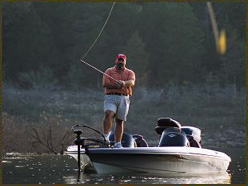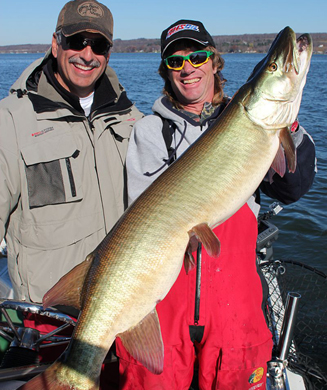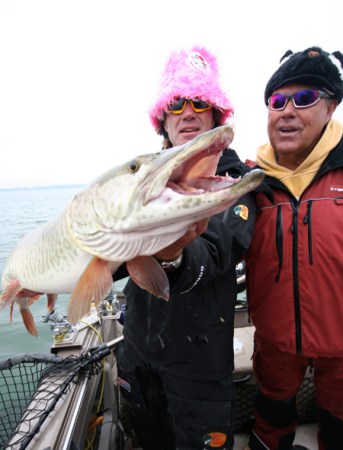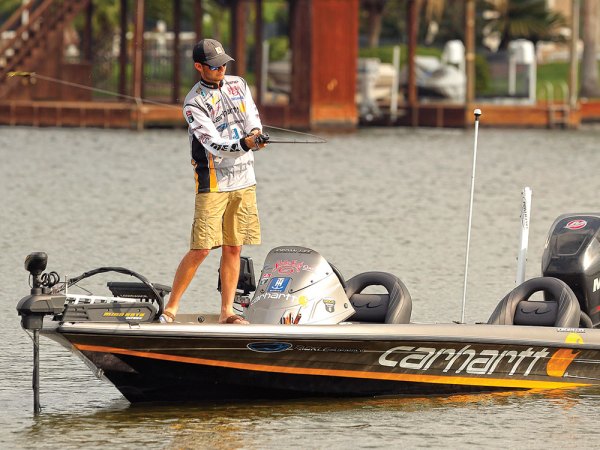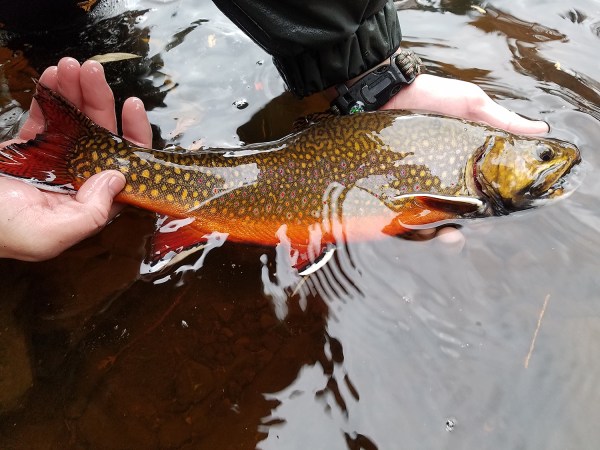Only an intellectually challenged angler would question the efficiency of short-range fishing methods. Flipping and pitching, two of the deadliest bass presentations ever, routinely put anglers within 15 to 30 feet of their quarry. Walleye fishermen often jig vertically in water as shallow as 10 feet. Muskie anglers goad many strikes by carving figure eights with their lures right next to the boat.
But don’t be misled. Fish aren’t always so gullible. In clear water, they may not tolerate a boat within 75 feet of them. And they often scatter over large expanses, leaving you no choice but to comb acres of water to pick them off. How about when matted vegetation, standing timber or other obstacles prevent you from getting within comfortable range of a fishy-looking spot?
Casting and Cranking
Bobby Padgett of Columbus, Ga., has earned wide acclaim for his ability to use diving crankbaits to dredge up prodigious numbers of summertime largemouths from Southern reservoirs. He sends his lures practically into orbit over underwater ledges, points, humps and flats, and retrieves them in depths of 6 to 20 feet or more.
“A long cast covers more water and keeps a crankbait running in the strike zone longer,” says Padgett. “It also allows the bait to dive a bit deeper. You know you’ve selected the right crankbait when it swims free most of the time but ticks the high spots. I normally don’t want my baits constantly digging bottom.”
Picture a crankbait’s path as an inverted arc from the time it splashes down to the time it reaches your rod tip. Once the lure hits the water and you start cranking, it has the potential to dive to a certain depth and maintain a generally horizontal trajectory until it nears its point of origin and is forced upward toward the rod. On short casts, the crankbait might not even reach its potential maximum descent, which might not be a bad thing under some circumstances. But when fishing ledges where bass might be posted over a wide range of structure at the same depth, you want the lure to cover as much of that fish-holding territory as possible. You cast as far as you can, knowing that the farther the line goes out, the longer the lure stays at a productive diving depth.
Padgett maximizes his casting reach with a 7-foot, medium-power All Star Model 845 bait-casting rod, which has a moderate-fast action. He claims fast-action rods react too quickly for many crankbaits. “If the tip is too fast, you’re inviting backlashes,” says Padgett. Stren Easy Cast 10- or 12-pound-test monofilament spooled on a Lew’s Speed Spool bait-caster complements Padgett’s long-distance outfit. The thinner 10-pound-test generates longer casts and gets crankbaits deeper, but Padgett prefers 12-pound-test when he can get away with it, because it provides better control over big bass and is less likely to break when casting a heavy crankbait.
Some anglers push the envelope when it comes to rod length. One such angler is Virginia bass pro Curt Lytle, who flexes an 8-foot medium-heavy power saltwater popping rod when he fishes crankbaits. “I can cast a crankbait at least 20 percent farther with an 8-foot rod than I can with a 7-footer,” says Lytle, who favors a Shimano Calcutta TE 200GT bait-casting reel. “That extra distance puts more bass in my livewell.”
Few anglers invoke long casts as often as Michigan’s Kevin VanDam, one of the most dominating anglers in the history of tournament bass fishing. Casts of 60 yards are no big deal when he guns heavy crankbaits with a 7-foot Quantum Kevin VanDam-model fiberglass cranking rod, 10-pound-test line and a Quantum Accurist 500 CX reel.
“The slower action of a fiberglass rod really increases the distance you get with crankbaits that weigh an ounce or more,” says VanDam.
When VanDam zaps a 3/4-ounce spinnerbait far over expansive submerged grass flats for largemouths, or vast roc reefs for Great Lakes smallmouths, he goes with a fast-action, 7-foot, medium-heavy-action graphite bait-casting rod. His objective is to cover water as fast as possible to run his spinnerbait over lone, aggressive bass.
“I prefer graphite with a spinnerbait because so many of the strikes, especially from big smallmouths, come on the first crank or two of the reel,” says VanDam. “The rod has to have enough backbone to set the hook on a long line and pressure the bass.”
VanDam matches his spinnerbait rod with a Quantum Energy 600PT reel that has a high-speed retrieve ratio of 6.3-to-1. When casting for smallmouths, he burns the spinnerbait so fast the water practically sizzles. Strikes are jolting; hence the need for 17-pound-test line. VanDam alternates jerkbaits and topwater lures in the same places he fishes heavy spinnerbaits, but he usually drops down to a 61/2-foot, medium-power graphite rod. The shorter rod sacrifices distance but lends itself better to the rod manipulations necessary to impart the “jerk-pause” action these baits require. [pagebreak]
Walleyes Way Out There
Tournament angler Ted Takasaki, who recently weighed in a five-fish limit of walleyes that topped 53 pounds, makes long casts when fishing for shallow walleyes that won’t tolerate a close approach. This is common in early spring when walleyes move to sun-warmed northern banks, points and pockets.
A St. Croix 7-foot Legend Elite spinning rod in a medium-light power handles most long-range applications for Takasaki. He pairs the rod with 6-pound-test Stren Magnathin and a Pflueger Trion front drag spinning reel. The limber rod whips a 1/16- or 1/8-ounce Fuzz-E-Grub jig tipped with a minnow far enough to reach walleyes without crowding them.
“My boat might be sitting in fifteen feet of water, but I’m catching walleyes only two feet deep,” says Takasaki. “By staying back, I might pull several fish from the same spot.” Subtle crankbaits, such as small Shad Raps, also score well for Takasaki when he makes long casts to boat-shy walleyes. These light lures cast poorly with bait-casting tackle but achieve some distance when heaved with a long spinning outfit.
In summertime, walleyes feed regularly on shallow, open-water reefs and rock piles. To reach the fish, Takasaki rigs his 7-foot rod with a Thill Center Slider float and a 1/8-ounce jig tipped with a leech. He anchors well upwind of the rocky structure, casts to the near edge of the sweet spot and lets the breeze push his float over the walleyes. Long casts let him stay farther away and pluck unsuspecting fish from the reef like grapes from a vine. Likewise, accomplished walleye champion Mark Brumbaugh opts for a rod that lets him cast natural baits a long way without worrying about the hook being bare by the time it lands.
“I prefer a 7-foot Berkley Series One spinning rod (SOS701ML) in medium-light power,” says Brumbaugh. “You can’t beat it for making long casts with floats, and the soft tip isn’t as apt to fling the bait off the hook.” His reel of choice is an Abu Garcia Cardinal 602. Mark Romanack is co-author of Precision Casting ($24.95; 800-353-6958; www.precisionangling.com), which charts the diving performance of 123 crankbaits. He believes that most anglers can cast crankbaits much farther with spinning tackle. “Distance with bait-casting tackle requires a high skill level to prevent backlashes,” says Romanack. “Most fishermen have fewer problems with a good spinning outfit-say, a G. Loomis graphite 7-foot, 6-inch rod in a medium-light power.”
A former walleye tournament angler, Romanack is convinced of the benefits of long-casting crankbaits to walleyes in places off-limits to trolling. One of his prime examples is the standing timber at Devils Lake in North Dakota, where major tournaments have been won by casting crankbaits into the trees.
“The ability to feel with a crankbait tells you when the lure is fouled with weeds,” says Romanack, who used a Quantum Response TI spinning reel when he tested crankbaits for his book. “Feeling the lure helps you keep it bumping tight to rocks, ledges and bottom contours. Best of all, you get to feel the hardest strike you’ll ever get walleye fishing.”
Far on the Flats
Stout rods built to withstand heavy bucktails, ponderous jerkbaits, oversized crankbaits, and the brute power of muskies that exceed 30 pounds usually aren’t designed with long casts in mind. But that hasn’t stopped innovative muskie authority Pete Maina of Hayward, Wis., from devising two long-cast methods for muskies and huge pike. He backs up his views with 26 years as a muskie guide and five national championships from the tournament circuit of Muskies, Inc.
“When we had nothing but stretchy monofilament, I avoided long casts because it was tough to get a good hook set with so much line out,” says Maina. “But with today’s low-stretch braided Spectra lines, I’m confident I’ll bury a barb, even on the end of a long cast.” Maina spools his Bass Pro Shops Pete Maina Signature Series Muskie Reel bait-caster with 80-pound-test TUF-Line braided line, which has the diameter of 30-pound-test monofilament. The business end of the line sports a 12-inch, 175-pound-test bronze wire leader. His current long-casting rod, an 81/2-foot graphite trigger stick, is a new addition to his signature series of muskie rods marketed through Bass Pro Shops. The rod has plenty of backbone and enough flex in the tip to propel heavy muskie lures 60 yards or more.
Maina wields his long rod in the spring, when muskies and big pike suspend near the surface in open water to feed on large baitfish, such as ciscoes, tulibees and shad. He tempts them with Ernie (6- and 9-inch) and Jake (10-inch) crankbaits, available from Muskie Mania Tackle (www.musky mania.com; 317-595-8724).
In some instances, Maina casts his crankbaits, which run 6 to 12 feet deep, over 100 feet of water. Why doesn’t he troll instead of cast the lure?
“You get a lot of followers trolling,” says Maina. “You end up taking a muskie or pike for a mile-long walk down the lake but they never hit. With a long-cast retrieve, you can present an extremely wounded-looking prey that encourages strikes.”
Casting with the wind allows Maina to achieve the greatest distance. He retrieves the crankbait with an erratic series of hard snaps mixed with intermittent pauses of varying lengths. He avoids anything that resembles a rhythmic cadence.
In spring, in summer and during autumn Indian-summer weather, Maina seines expansive flats 3 to 12 feet deep with his long rod matched with big bucktail spinners and topwater plugs, such as the 9-inch Doc.
“I fish large areas that don’t have a distinct break or edge o a crankbait tells you when the lure is fouled with weeds,” says Romanack, who used a Quantum Response TI spinning reel when he tested crankbaits for his book. “Feeling the lure helps you keep it bumping tight to rocks, ledges and bottom contours. Best of all, you get to feel the hardest strike you’ll ever get walleye fishing.”
Far on the Flats
Stout rods built to withstand heavy bucktails, ponderous jerkbaits, oversized crankbaits, and the brute power of muskies that exceed 30 pounds usually aren’t designed with long casts in mind. But that hasn’t stopped innovative muskie authority Pete Maina of Hayward, Wis., from devising two long-cast methods for muskies and huge pike. He backs up his views with 26 years as a muskie guide and five national championships from the tournament circuit of Muskies, Inc.
“When we had nothing but stretchy monofilament, I avoided long casts because it was tough to get a good hook set with so much line out,” says Maina. “But with today’s low-stretch braided Spectra lines, I’m confident I’ll bury a barb, even on the end of a long cast.” Maina spools his Bass Pro Shops Pete Maina Signature Series Muskie Reel bait-caster with 80-pound-test TUF-Line braided line, which has the diameter of 30-pound-test monofilament. The business end of the line sports a 12-inch, 175-pound-test bronze wire leader. His current long-casting rod, an 81/2-foot graphite trigger stick, is a new addition to his signature series of muskie rods marketed through Bass Pro Shops. The rod has plenty of backbone and enough flex in the tip to propel heavy muskie lures 60 yards or more.
Maina wields his long rod in the spring, when muskies and big pike suspend near the surface in open water to feed on large baitfish, such as ciscoes, tulibees and shad. He tempts them with Ernie (6- and 9-inch) and Jake (10-inch) crankbaits, available from Muskie Mania Tackle (www.musky mania.com; 317-595-8724).
In some instances, Maina casts his crankbaits, which run 6 to 12 feet deep, over 100 feet of water. Why doesn’t he troll instead of cast the lure?
“You get a lot of followers trolling,” says Maina. “You end up taking a muskie or pike for a mile-long walk down the lake but they never hit. With a long-cast retrieve, you can present an extremely wounded-looking prey that encourages strikes.”
Casting with the wind allows Maina to achieve the greatest distance. He retrieves the crankbait with an erratic series of hard snaps mixed with intermittent pauses of varying lengths. He avoids anything that resembles a rhythmic cadence.
In spring, in summer and during autumn Indian-summer weather, Maina seines expansive flats 3 to 12 feet deep with his long rod matched with big bucktail spinners and topwater plugs, such as the 9-inch Doc.
“I fish large areas that don’t have a distinct break or edge o
